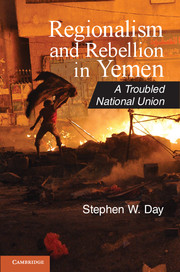Book contents
- Frontmatter
- Contents
- Tables
- Maps and Photos
- Preface
- Acknowledgments
- Abbreviations
- Chronology of Modern Yemeni History
- Glossary of Names of Key Political Figures
- Introduction
- 1 Understanding the Regional Divisions of Yemen
- 2 Two Revolutions, Two Republics
- 3 Salih Family Rules and the Sanhan Tribe
- 4 Unity in Name Only
- 5 The Spoils of Civil War
- 6 A Regime in Control?
- 7 Political Eruptions after 9/11
- 8 The Return of Yemeni Regionalism
- 9 Yemen’s Political Meltdown
- Conclusion
- Appendix
- Bibliography
- Index
- References
9 - Yemen’s Political Meltdown
Published online by Cambridge University Press: 05 July 2012
- Frontmatter
- Contents
- Tables
- Maps and Photos
- Preface
- Acknowledgments
- Abbreviations
- Chronology of Modern Yemeni History
- Glossary of Names of Key Political Figures
- Introduction
- 1 Understanding the Regional Divisions of Yemen
- 2 Two Revolutions, Two Republics
- 3 Salih Family Rules and the Sanhan Tribe
- 4 Unity in Name Only
- 5 The Spoils of Civil War
- 6 A Regime in Control?
- 7 Political Eruptions after 9/11
- 8 The Return of Yemeni Regionalism
- 9 Yemen’s Political Meltdown
- Conclusion
- Appendix
- Bibliography
- Index
- References
Summary
Following the terrorist incident in the skies over Detroit, Michigan in December 2009, American media referred to Yemen as al-Qaeda’s “new safe haven.” According to one theory at the time, when U.S. and coalition forces increased their operations in Afghanistan and the border region with Pakistan in 2008–2009, al-Qaeda fighters fled the mountains and deserts of South Asia for a similar, yet more secure environment on the southwest corner of the Arabian peninsula. Western journalists descended on Sanaa in droves, seeking the latest secrets and mysteries of this obscure land. In January 2010, news headlines about threats emanating from Yemen splashed across American television screens, newspapers, and political magazines. For the first time since the USS Cole bombing in 2000, Yemen was back in the public spotlight.
Inside Washington, DC, some commentators described President Barack Obama as “caught off guard” by the attempted terrorist attack aboard Northwest Flight 253. There was renewed talk of U.S. intelligence officers “failing to connect the dots” before al-Qaeda reached American soil. A few members of Congress fed a growing public hysteria by portraying the president as weak on national security. Connecticut Senator Joseph Lieberman called for a ground invasion of Yemen to wipe out al-Qaeda’s base of operations. Despite the panicked reaction on Capitol Hill and in the media, President Obama already had his sights on Yemen. Over the preceding year, his counterterrorism advisor John Brennan, and military commanders like General David Petraeus, made repeated visits to the country, in order to discuss the need for greater coordination with President Salih. Furthermore, prior to the Christmas Day incident, U.S. military forces carried out two attacks inside Yemen, although these operations were denied at the time by White House officials.
- Type
- Chapter
- Information
- Regionalism and Rebellion in YemenA Troubled National Union, pp. 256 - 289Publisher: Cambridge University PressPrint publication year: 2012



